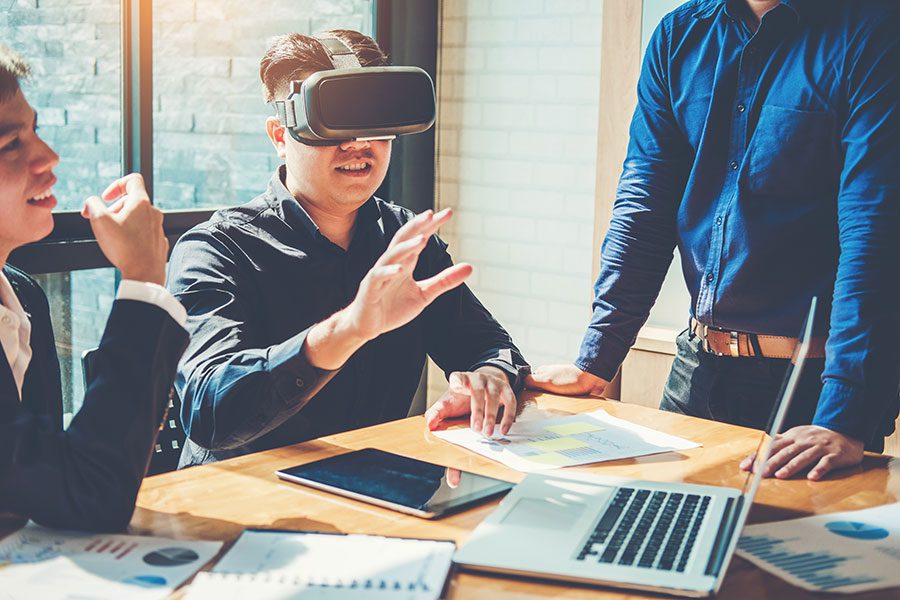Traditional workplace learning methods are gearing up to make way for the methods of the future in 2024.
Here at MDA Training, we strive to keep our workplace learning methods on the cusp of innovation, and so are always on the lookout for the trends that are set to shape the years to come.
We predict that the three workplace learning methods that are positioned to shape 2024 are:
- Virtual reality
- Artificial intelligence
- Group coaching
Virtual reality
Virtual reality (VR) has been heralded as the next big innovation in the workplace for some time, and 2024 is set to be the year when this high-tech learning method truly comes into its own.
Virtual reality is computer-based technology that is capable of stimulating a 3D image or environment for the user to interact with. This adds a level of realism to workplace learning, that may increase retention of information due to the experiential nature of the technology.
Another benefit of using virtual reality as a workplace learning method is that it is a flexible method that can be used at any time, and in any location, which may cut the costs of training overall.
Virtual learning also provides users with a risk-free environment through which they can explore complex scenarios, without fear of failure. This allows participants to simply focus on the training exercise and not concern themselves with the consequences of making a mistake.
Commercial giants such as Walmart have already embraced VR, and have already delivered hundreds of thousands of modules of training using the technology. Walmart also claims that “the use of VR has increased understanding by 5 to 15 per cent” with the main appeal being that the training is “on-demand and (can be) repeated often to reinforce the new information.”
Artificial intelligence
Artificial intelligence (AI) can be defined as “The theory and development of computer systems able to perform tasks normally requiring human intelligence, such as visual perception, speech recognition, decision-making, and translation between languages.”
This advanced technology is set to create a huge impact in the world of workplace learning in 2024 and is being more widely adopted into training programmes as recognition of its effectiveness increases across the globe.
So how exactly can artificial intelligence improve workplace learning?
A more tailored and effective learning experience
Artificial intelligence allows an advanced computer to recognise the individual needs of users, thereby adjusting training to specific goals. This makes training more valuable and efficient, as time is not being spent on training participants in areas that they are already proficient in.
Reinforcement of information
Unlike workplace learning that is led by humans, the use of artificial intelligence means that participants can return to training at any point. This allows people to reinforce the information and solidify what they have learnt.
Quantifiable results and ROI
Measuring the effectiveness of human-led learning methods is difficult and prone to natural human error. With AI, however, data collected from training exercises can easily be quantified and organised into accurate reports. This allows businesses to judge which training courses are effective and which areas people need to improve in.
The technology could also be used for on-the-job feedback, for instance, while engineers carry out their work. This could prove invaluable for workplace learning and increasing worker confidence.
Group coaching
While individual coaching has previously been the focus of many workplace learning methods, the group coaching session is set to be the preferred choice of 2024.
One reason for this shift in opinion is that group coaching allows for a more communal sharing of viewpoints between co-workers; this allows people to connect with one another and develop stronger bonds as a team. Group coaching sessions also allow for team building activities, which will, in turn, benefit team development.
Group sessions are also more time-efficient than individual ones, and skills boosted as a team which can increase morale and make future team projects flow far more smoothly, as each member of the team already has an idea of where each member’s strengths lie.
Ensuring that teams of co-workers have strong bonds and a good understanding of each other is highly beneficial to a business, as this is sure to contribute to greater collective productivity and happiness in the workplace.
In conclusion
These three workplace learning methods are well on the way to creating a significant impact on the training landscape in 2024.
To ensure that your business is getting the best results from their workplace training methods, it is crucial that you consider incorporating virtual reality, artificial intelligence and group learning into your 2024 workplace learning strategy.










